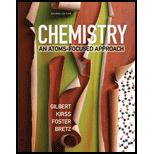
To find:
Moles and atoms of iron in the given compounds.
Answer to Problem 2.76QA
Solution:
a) 2.5 moles of wolframite - FeWO4 contain 2.5 moles and 1.5 x 1024 atoms of Iron.
b) 2.5 moles of pyrite- FeS2 contain 2.5 moles and 1.5 x 1024 atoms of Iron
c) 2.5 moles of magnetite - Fe3O4 contain 7.5 moles and 4.5 x 1024 atoms of Iron.
d) 2.5 moles of hematite - Fe2O3 contain 5.0 moles and 3.0 x 1024 atoms of Iron.
Explanation of Solution
Calculations:
a) 2.5 moles of FeWO4
In one molecule of FeWO4, there is one atom of Fe. Therefore, we can say that the mole ratio between FeWO4 and Fe is 1:1. Now, we have the mole to mole ratio and moles of FeWO4. So, we can calculate the moles of Fe by using the dimensional analysis as below.
So, 2.5 moles of FeWO4 contain 2.5 moles of Fe.
Now, we convert moles into atoms. We know that in every 1 mol of substance, we have 6.023 x 1023 molecules or atoms of given substance, which is equal to
Using this conversion factor, we will convert 2.5 mol of Fe to atoms of Fe.
So, 2.5 moles of FeWO4 contain 1.5 x 1024 atoms of Fe.
b) 2.5 moles of FeS2
In one molecule of FeS2, there is one atom of Fe. Therefore, we can say that the mole ratio between FeS2 and Fe is 1:1. Now, we have the mole to mole ratio and moles of FeS2. So, we can calculate the moles of Fe by using dimensional analysis as below.
So, 2.5 moles of FeS2 contains 2.5 moles of Fe.
Now, we convert moles into atoms. We know that in every 1 mol of substance, we have 6.023 x 1023 molecules or atoms of the given substance, which is equal to Avogadro’s number.
Using this conversion factor, we will convert 2.5 mol of Fe to atoms of Fe.
So, 2.5 moles of FeS2 contain 1.5 x 1024 atoms of Fe.
c) 2.5 moles of Fe3O4
In one molecule of Fe3O4, there are three atoms of Fe. Therefore, we can say that the mole ratio between Fe3O4 and Fe is 1:3. Now, we have the mole to mole ratio and moles of Fe3O4. So, we can calculate the moles of Fe by using the dimensional analysis as below.
So, 2.5 moles of Fe3O4 contains 7.5 moles of Fe.
Now, we convert moles into atoms. We know that in every 1 mol of substance, we have 6.023 x 1023 molecules or atoms of given substance, which is equal to Avogadro’s number.
Using this conversion factor, we will convert 7.5 mol of Fe to atoms of Fe.
So, 2.5 moles of Fe3O4 contain 4.5 x 1024 atoms of Fe.
d) 2.5 moles of Fe2O3
In one molecule of Fe2O3, there are two atoms of Fe. Therefore, we can say that the mole ratio between Fe2O3 and Fe is 1:2. Now, we have the mole to mole ratio and moles of Fe2O3. So, we can calculate the moles of Fe by using dimensional analysis as below.
So, 2.5 moles of Fe2O3 contains 5.0 moles of Fe.
Now, we convert moles into atoms. We know that in every 1 mol of substance, we have 6.023 x 1023 molecules or atoms of given substance, which is equal to Avogadro’s number.
Using this conversion factor, we will convert 5.0 mol of Fe to atoms of Fe.
So, 2.5 moles of Fe2O3 contains 3.0 x 1024 atoms of Fe.
Conclusion:
a) 2.5 moles of wolframite - FeWO4 contain 2.5 moles and 1.5 x 1024 atoms of Iron.
b) 2.5 moles of pyrite- FeS2 contain 2.5 moles and 1.5 x 1024 atoms of Iron
c) 2.5 moles of magnetite - Fe3O4 contain 7.5 moles and 4.5 x 1024 atoms of Iron.
d) 2.5 moles of hematite - Fe2O3 contain 5.0 moles and 3.0 x 1024 atoms of Iron.
Want to see more full solutions like this?
Chapter 2 Solutions
CHEMISTRY:ATOMS-FOCUSED..-ACCESS
 ChemistryChemistryISBN:9781305957404Author:Steven S. Zumdahl, Susan A. Zumdahl, Donald J. DeCostePublisher:Cengage Learning
ChemistryChemistryISBN:9781305957404Author:Steven S. Zumdahl, Susan A. Zumdahl, Donald J. DeCostePublisher:Cengage Learning ChemistryChemistryISBN:9781259911156Author:Raymond Chang Dr., Jason Overby ProfessorPublisher:McGraw-Hill Education
ChemistryChemistryISBN:9781259911156Author:Raymond Chang Dr., Jason Overby ProfessorPublisher:McGraw-Hill Education Principles of Instrumental AnalysisChemistryISBN:9781305577213Author:Douglas A. Skoog, F. James Holler, Stanley R. CrouchPublisher:Cengage Learning
Principles of Instrumental AnalysisChemistryISBN:9781305577213Author:Douglas A. Skoog, F. James Holler, Stanley R. CrouchPublisher:Cengage Learning Organic ChemistryChemistryISBN:9780078021558Author:Janice Gorzynski Smith Dr.Publisher:McGraw-Hill Education
Organic ChemistryChemistryISBN:9780078021558Author:Janice Gorzynski Smith Dr.Publisher:McGraw-Hill Education Chemistry: Principles and ReactionsChemistryISBN:9781305079373Author:William L. Masterton, Cecile N. HurleyPublisher:Cengage Learning
Chemistry: Principles and ReactionsChemistryISBN:9781305079373Author:William L. Masterton, Cecile N. HurleyPublisher:Cengage Learning Elementary Principles of Chemical Processes, Bind...ChemistryISBN:9781118431221Author:Richard M. Felder, Ronald W. Rousseau, Lisa G. BullardPublisher:WILEY
Elementary Principles of Chemical Processes, Bind...ChemistryISBN:9781118431221Author:Richard M. Felder, Ronald W. Rousseau, Lisa G. BullardPublisher:WILEY





